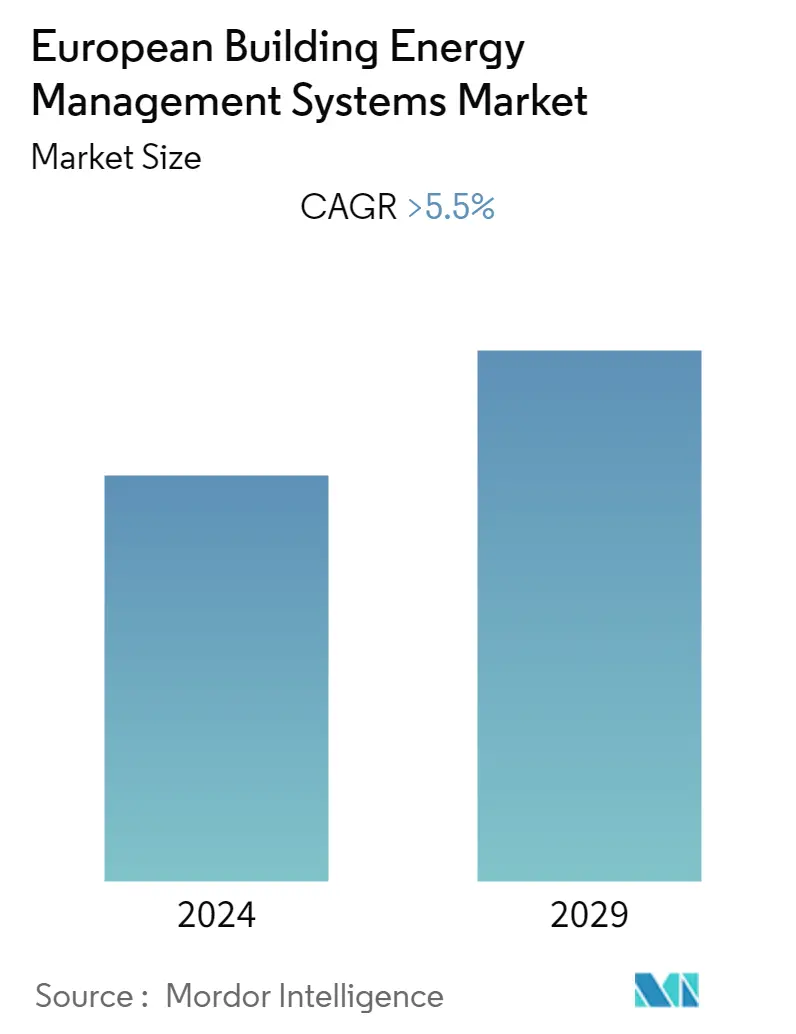Market Size of European Building Energy Management Systems Industry

| Study Period | 2020 - 2029 |
| Base Year For Estimation | 2023 |
| Forecast Data Period | 2024 - 2029 |
| Historical Data Period | 2020 - 2022 |
| CAGR | 5.50 % |
| Market Concentration | Medium |
Major Players
*Disclaimer: Major Players sorted in no particular order |
European Building Energy Management Systems Market Analysis
The European building energy management systems (BEMS) market is expected to witness a CAGR of more than 5.5% during the forecast period. The COVID-19 impact on the market was diverse in different parts of the continent. In some countries, the energy consumption was not affected much, as in Germany, where the industrial and commercial activity continued to remain the same even during the first wave. On the other hand, in the countries, like Italy and Spain, the industries were severely affected. Thus, the energy consumption was less. Thus, the European BEMS market had a mixed response during the COVID-19 pandemic. The two main factors that are largely responsible for the growth of the market are the advanced versions of these systems, which provide additional data such as utility billing, weather data, etc., and real estate smart development in many European countries. However, high costs and fewer incentives for the BEMS technology are expected to hinder the market growth.
- The residential segment is expected to dominate the market due to the high consumption of energy during extremely cold winters.
- The net-zero carbon emissions and energy efficiency targets in many European countries are the biggest opportunities for the BEMS market. For example, the European Commission has set a new proposal for Energy Efficiency Directive (EED) targets during the Informal Energy Council meeting held in 2021. The target was planned to be 39% as EED for final energy consumption by 2030, which is currently set at 32.5%.
- The United Kingdom is likely to be at the forefront in the BEMS market during the forecast period due to the various energy efficiency plans set by the country.
European Building Energy Management Systems Industry Segmentation
The European building energy management systems market report includes:
| Type | |
| Software | |
| Hardware |
| Deployment | |
| Residential | |
| Commercial | |
| Industrial |
| Geography | |
| Germany | |
| Italy | |
| United Kingdom | |
| France | |
| Rest of Europe |
European Building Energy Management Systems Market Size Summary
The European building energy management systems (BEMS) market is poised for significant growth, driven by advancements in technology and the increasing focus on smart real estate developments across the continent. The market's response to the COVID-19 pandemic varied, with countries like Germany maintaining steady energy consumption due to ongoing industrial and commercial activities, while others such as Italy and Spain experienced declines. Despite challenges such as high costs and limited incentives, the market is expected to benefit from the push towards net-zero carbon emissions and energy efficiency targets set by various European nations. The residential segment is anticipated to lead the market, particularly in regions with harsh winters, where energy consumption is high. Innovations like Schneider Electric's Wiser Energy Center and collaborative projects in Italy highlight the ongoing developments aimed at enhancing energy efficiency and reducing costs.
The United Kingdom is expected to take a leading role in the European BEMS market, supported by robust energy efficiency plans and a thriving construction industry. Government initiatives such as the "Green Industrial Revolution" and energy conservation schemes like the Green Deal are pivotal in driving market growth. The UK's focus on achieving net-zero carbon emissions by 2050 through technological improvements and data-driven decision-making is a key factor in its market leadership. The market is moderately consolidated, with major players like Siemens AG, Honeywell International Inc., and Schneider Electric SE playing significant roles. Projects such as Lyon Confluence in France and the Collecteif project across multiple European countries underscore the region's commitment to integrating energy management systems in smart buildings, further propelling market expansion.
European Building Energy Management Systems Market Size - Table of Contents
-
1. MARKET OVERVIEW
-
1.1 Introduction
-
1.2 Market Size and Demand Forecast in USD million, till 2027
-
1.3 Recent Trends and Developments
-
1.4 Government Policies and Regulations
-
1.5 Market Dynamics
-
1.5.1 Drivers
-
1.5.2 Restraints
-
-
1.6 Supply Chain Analysis
-
1.7 Porter's Five Forces Analysis
-
1.7.1 Threat of New Entrants
-
1.7.2 Bargaining Power of Consumers
-
1.7.3 Bargaining Power of Suppliers
-
1.7.4 Threat of Substitute Products/Services
-
1.7.5 Intensity of Competitive Rivalry
-
-
-
2. MARKET SEGMENTATION
-
2.1 Type
-
2.1.1 Software
-
2.1.2 Hardware
-
-
2.2 Deployment
-
2.2.1 Residential
-
2.2.2 Commercial
-
2.2.3 Industrial
-
-
2.3 Geography
-
2.3.1 Germany
-
2.3.2 Italy
-
2.3.3 United Kingdom
-
2.3.4 France
-
2.3.5 Rest of Europe
-
-
European Building Energy Management Systems Market Size FAQs
What is the current European Building Energy Management Systems Market size?
The European Building Energy Management Systems Market is projected to register a CAGR of greater than 5.5% during the forecast period (2024-2029)
Who are the key players in European Building Energy Management Systems Market?
Siemens AG, Honeywell International Inc., Schneider Electric SE, ABB Ltd. and Johnson Controls International Plc. are the major companies operating in the European Building Energy Management Systems Market.

